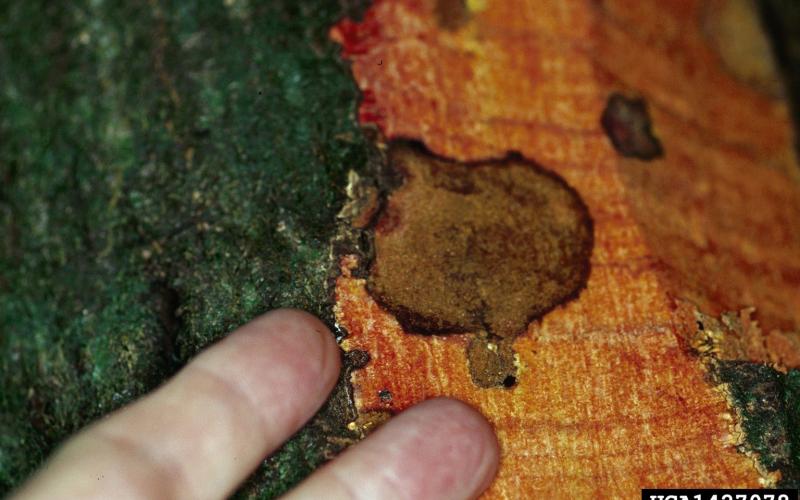Scientific name: Phytophthora ramorum
Native range: unknown
At Risk
Oak trees have been the most susceptible hosts for sudden oak death in the U.S., but many other plants can also be infected and carry the pathogen. In California and Oregon, Phytophthora ramorum is responsible for killing an estimated 30 to 45 million trees. Over 150 other plants can also be infected by P. ramorum, including many popular nursery and landscape plants like rhododendron, viburunum, and lilac.
Distribution
Sudden oak death was first officially reported in California in 2000 and was found in Europe around the same time. The origin of Phytophthora ramorum is unknown.
In the U.S., Phytophthora ramorum is now known to occur in California, Oregon and Washington in both coastal forests and in some plant nurseries. On several occasions, P. ramorum has been moved on infected nursery plants to areas where sudden oak death does not occur. This has resulted in the quarantine and decontamination of nurseries that received infected plant material.
Biology
Phytophthora ramorum is a water mold that can survive in infected plants, soil and leaf litter, and in streams and ponds. Spores can be spread short distances on splashing rain or irrigation, and long distance on infected plants or soil. The most likely way that P. ramorum would arrive in Minnesota is on infected plants. Once a nursery is infected with P. ramorum it has proven difficult to eradicate and can affect a nurseries ability to export and sell plants.
Disease differs depending on what host is infected. In oak trees, large bleeding cankers form on the main trunk. The infections interrupt the flow of water and nutrients from the roots to the canopy and the tree often dies. In other hosts, the disease causes leaf spots and shoot blight but does not kill the plant. These types of infections often produce large numbers of spores that can be spread by splashing water.
Find more information about Phytophthora ramorum here https://www.apsnet.org/edcenter/disandpath/oomycete/pdlessons/Pages/SuddenOakDeath.aspx
Identification
Symptoms of infection by P. ramorum differ based on which host plant is infected.
Rhododendron and other Ornamental Shrubs
Many commonly grown landscape shrubs are susceptible to infection by Phytophthora ramorum. Some common symptoms found on ornamental shrubs include large brown blotches on leaves or wilted leaves with a brown edge. Young green stems and shoots turn brown and shrivel. Leaves attached to infected stems wilt and may have a dark brown line extending down the center of the leaf from the base. Phytophthora ramorum often does not kill rhododendrons or other ornamental landscape shrubs.
Oak Trees
In oak trees, Phytophthora ramorum infects the main trunk of mature trees. This infection causes a “bleeding” canker in which wood and bark turn reddish brown, and red liquid seeps out from cracks in the bark. The pathogen destroys the tissue that transports food and water throughout the tree. When most of the trunk is infected, leaves quickly turn brown and the tree dies.
Identifying sudden oak death is not easy and will require expert laboratory analysis.
A number of other more likely problems affect oak trees in Minnesota and should be considered when diagnosing potential problems:
- Oak wilt is a common problem for oak trees from southeastern Minnesota to the Brainerd and northern Pine County areas.
- Bur oak blight is a recently discovered problem and has been confirmed to occur throughout Minnesota.
- Other Phytophthora species besides sudden oak death can also impact oaks and other trees in Minnesota.
For help diagnosing problems on oak trees, consult the University of Minnesota “What’s Wrong With my Plant?” (https://apps.extension.umn.edu/garden/diagnose/plant/deciduous/oak/) for oaks or submit a sample to the UMN Plant Disease Clinic (http://pdc.umn.edu).
Regulatory Status: Regulated
Sudden oak death is regulated at the state and federal level. States with known infections and USDA APHIS regulate the movement of host nursery stock from infected nurseries to prevent the movement of sudden oak death to other areas.
What Can I Do?
Contact the Minnesota Department of Agriculture via Report a Pest if you suspect you have found Sudden Oak Death.
Smarty Plants Podcast
 Discover Smarty Plants, the Minnesota Department of Agriculture's podcast that digs into the fascinating world of invasive species. Join expert guests as they share insights and solutions to protect our environment and agricultural resources. Visit Smarty Plants and start listening today.
Discover Smarty Plants, the Minnesota Department of Agriculture's podcast that digs into the fascinating world of invasive species. Join expert guests as they share insights and solutions to protect our environment and agricultural resources. Visit Smarty Plants and start listening today.





